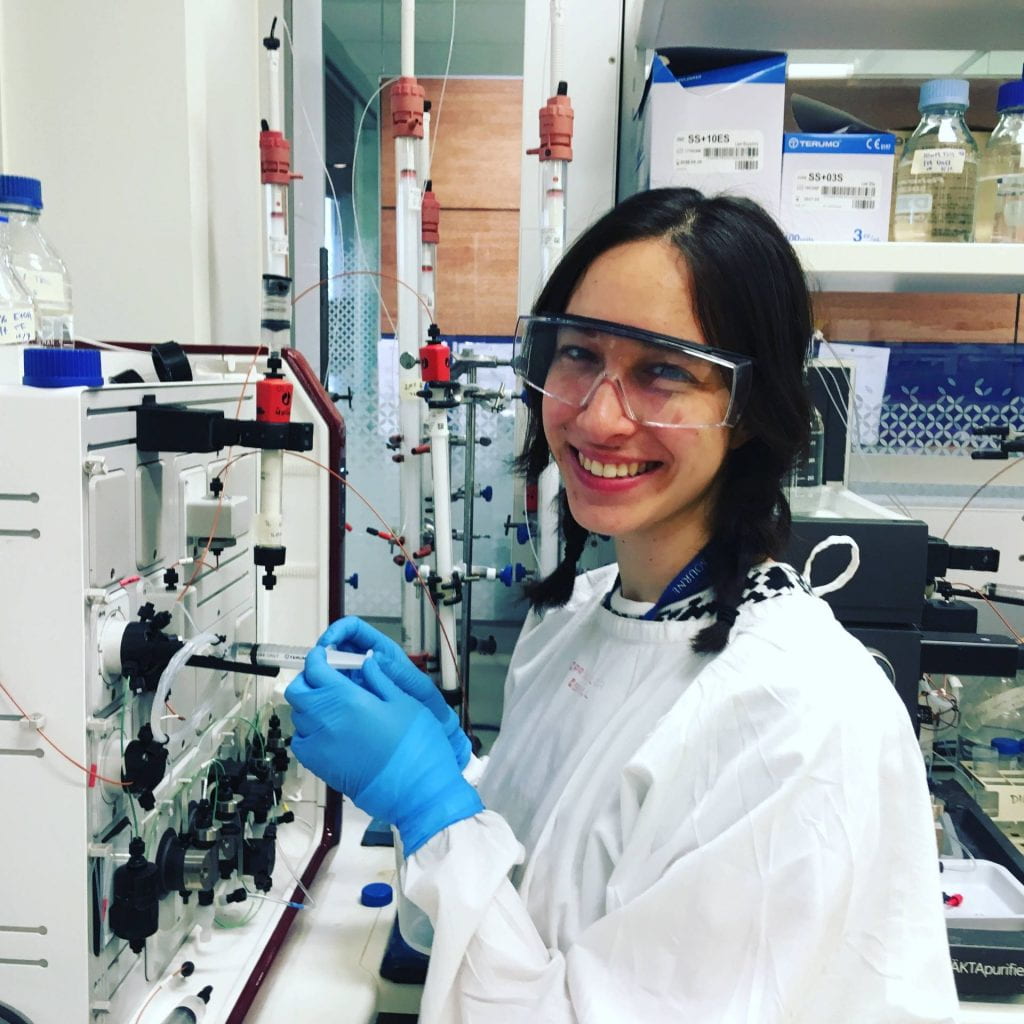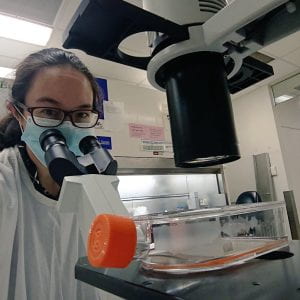
Feature Friday: Catriona Nguyen-Robertson
We’ve all heard about the “new car” conundrum. As soon as you think you want to buy a new car (a red Mazda 2 in my case), you start seeing it EVERYWHERE. Like, “Were there always this many red Mazda 2’s on the street, or am I just noticing them now?”
Well I feel like Catriona Nguyen-Robertson is the Melbourne Science scene equivalent. I think I first met her at a Convergence Science Network event in 2017, and since then, I’ve been seeing her EVERYWHERE! Chairing panel discussions, at networking events, in the Science Gallery SciCurious team, and now we’re working together as part of the UniMelbSciComm staff team. I kept asking myself “who IS this girl and how is she just totally bossing the STEM world??”

So in case you’ve been noticing her everywhere and also wondering who she is, I’m delighted to introduce her to you today.
Catriona is a woman of many talents. She’s a PhD candidate at the Peter Doherty Institute for Infection and Immunity, she’s a Science Communications Officer for the Royal Society of Victoria and Convergence Science Network, AND she’s the Associate Editor of the scientific journal, Immunology & Cell Biology. She’s also a member of a number of science outreach programs, such as Skype a Scientist, Pint of Science, In2Science, BrainSTEM, and the Gene Technology Access Centre. You’d think it’s impossible for one person to be everywhere at once (anyone else think she’s got a time-turner?), but I can guarantee you that if you’re active in Melbourne’s science outreach or engagement scene, you’ll absolutely come across this superstar along the way.
But one of the main reasons I’m writing about her today is to introduce you to her YouTube Channel, Nyuroscientist, where she sings about all things science. Yes you read that right, SINGS!
Catriona’s been singing in school choirs since prep, and started to accompany herself on the piano in high school. She was elected as music captain in year 12, and would organise performances for school assemblies, including singing some of her own songs like I Am A Woman for International Women’s Day, and I’m Scotnamese for Multicultural Week.
She was also invited to sing for the Vietnamese Community of Australia/Dual Identity Leadership Program in 2015, in recognition of 40 years since Vietnamese refugees came to Australia. She wrote a song about her mother’s story of migrating from Vietnam to Australia.

She was also a scholarship singer with the St Patrick’s Cathedral Singers and has been singing in the Melbourne Symphony Orchestra Chorus since 2017.
The first time she wrote a science song was for Science Gallery Melbourne last year. She was invited to speak at the Disposable Poetry Slam as a scientist. The subject was “human waste” – which she proclaims is “definitely not my area of expertise as a scientist.”
“I had Imposter Syndrome (something I know many of us get) and didn’t know what to talk about or how to do it. For 15 minutes too! I spoke about digestion and the production of poo and wee, and then I summarised both parts with songs: A Song in the Key of Pee and Poos Blues. Science Gallery is all about being creative, so I thought that singing would be a good way to add a bit of artistic flare to the science.”
Catriona has since re-recorded Poos Blues with for her YouTube channel.
Singing about science was such a hit, she decided to write another original piece for the FameLab Australia Final last year, adapting music from Matilda to tell the story of her research on how exercise impacts the immune system.
She’s since found that summarising her talks with songs is a really effective way to help the messages stick. She’s used this technique in this year’s PintOnlineAU, the COVID-19 friendly version of Pint of Science, as well as in Skype A Scientist, where she rounds off each presentation with a song about T cells.
This year the University of Melbourne offered Student Engagement Grants, where Catriona pitched the idea of creating more science songs to help students engage with content. She managed to get the grant, which helped her purchase a microphone and the gear needed to record her awesome songs in high quality.
“My idea is to write ‘Scientific Earworms’ – science that gets stuck in your head. There are some songs that everyone knows the lyrics to, so what if they were educational?
Gregory Crowther wrote a review of a number of studies in 2012 specifically about the idea of using science songs in education, but it’s still not widely used in practice. Studies have so far been promising, suggesting an increased recall capacity and better performance in tests/assessments if the students listened to songs about the subject matter. This is all preliminary – but there’s definitely an opening.
This makes sense, given the idea of ‘cement memory’. It gets harder and harder to pack more information in our brains, but we remember information with more associations attached, like more routes to access the memory. Information in music would have many more pathways than reading something in a textbook because you’ve got the associated tune, rhythm, instrument(s), and so on.”
She launched her channel this May with Solving COVID-19 (watch at own risk – this one is extremely catchy!!)
“My goal is to teach more people (especially younger children) about science in a fun way. Jargon is less scary if it’s in a song. The longest word I know is supercalifragilisticexpialidocious – and it sticks because Mary Poppins sings it! So hopefully people will be singing about immunology too!”
When she’s not getting incredibly catchy songs stuck in our heads, she’s also researching in immunology about T Cells that react to fats and oil molecules. She’s focussed on interactions that cause tuberculosis, as well as oils in sunscreens and beauty products that can trigger an immune reaction in skin allergies.
She explains it all in a nutshell really well in her 3 Minute Thesis grand finalist entry here:
She’s a whiz at presenting her research, and in 2020 alone she’s been the recipient of Best Poster Presentation at the European Molecular Biology Laboratories Australia Postgraduate Symposium, Best Presentation by Immunology Group of Victoria and Audience Choice Award at Victorian Infection and Immunity Network’s Symposium.
“I get nervous before a talk if I know it’s assessed. Funnily enough, it’s not public speaking that’s the problem, it’s the being judged part. Yet once I start speaking, I channel the adrenaline into excitement rather than nervous energy – it’s like a rush.”

“Some scientific discovery stories are just as good as fiction. Why not tell them to the world? It would be great if the researchers doing the work could show off their incredible work with everyone themselves. That’s why I think it’s important to train scientists to communicate their work to a lay audience. They also need to communicate to an inter-disciplinary audience because science is becoming more and more interdisciplinary. Medicos need to talk to biomedical engineers. Statisticians with biologists. Chemists with astrophysicists.
We also need it to get important messages across and inform policy. Climate change, a pandemic, pollution, food insecurity – these are all global challenges that will be solved by STEM (Science, Technology, Engineering and Maths).
I also want to teach science to younger people in particular to either encourage them to get into STEM, or even just empower them to be more critical thinkers and consider the information out there. It’s a world of fake news at the moment. Hopefully, with more science communication, we can steer people away from misinformation and more towards better decision-making that’s evidence based.”

She’s also the unofficial “resident immunologist” on Curiosity Killed the Rat, a science podcast run by one of our former students Kate Huckstep. She’s spoken with Kate and their brother Matt on the podcast about The Immunoverse and Exercise.
You can find Catriona on Twitter at @CatrionaNR, and her YouTube Channel Nyuroscientist.
– Written by Rosie Arnold
Categories